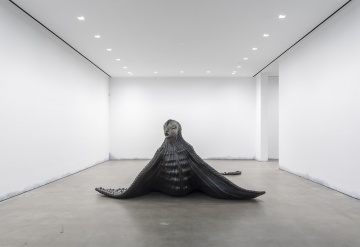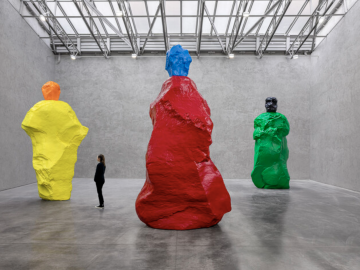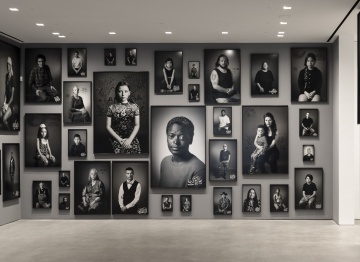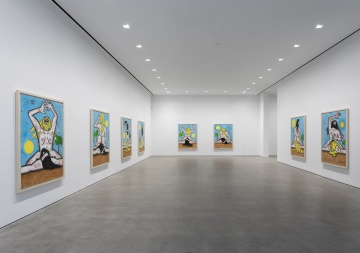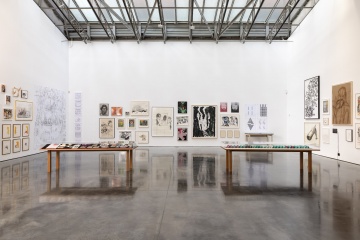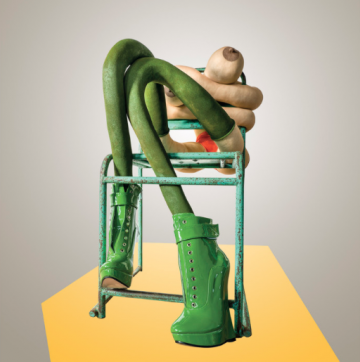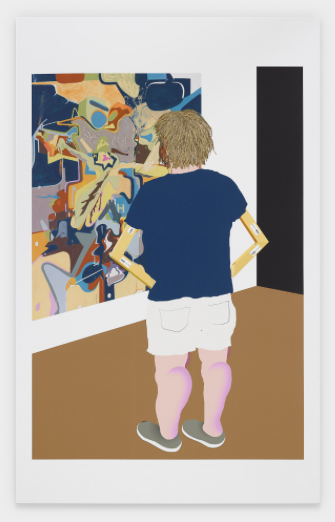Gladstone Gallery
515 West 24th Street
New York, NY 10011
212 206 9300
Also at:
530 West 21st Street
New York, NY 10011
212 206 7606
130 East 64th Street
New York, NY 10065
212 753 2200
Tweets by GladstoneNYC
New York, NY 10011
212 206 9300
Also at:
530 West 21st Street
New York, NY 10011
212 206 7606
130 East 64th Street
New York, NY 10065
212 753 2200
Artists Represented:
Ricci Albenda
Richard Aldrich
Allora & Calzadilla
Kai Althoff
Miroslaw Balka
Matthew Barney
Robert Bechtle
Alighiero Boetti
Kasper Bosmans
Kerstin Brätsch
Ian Cheng
Anne Collier
Claudia Comte
Carroll Dunham
Cecilia Edefalk
Roe Ethridge
Cyprien Gaillard
Maureen Gallace
Guo Fengyi
LaToya Ruby Frazier
Keith Haring
Thomas Hirschhorn
Jim Hodges
Huang Yong Ping
Arthur Jafa
Cameron Jamie
Joan Jonas
Birgit Jürgenssen
Alex Katz
Pierre Klossowski
Jannis Kounellis
Mark Leckey
Sharon Lockhart
Andrew Lord
Sarah Lucas
Victor Man
Robert Mapplethorpe
Mario Merz
Marisa Merz
Jill Mulleady
Wangechi Mutu
Jean-Luc Mylayne
Shahryar Nashat
Shirin Neshat
Damián Ortega
Philippe Parreno
Elizabeth Peyton
Walter Pichler
Richard Prince
R. H. Quaytman
Ugo Rondinone
Rachel Rose
Mimmo Rotella
Salvo
Gedi Sibony
Amy Sillman
Jack Smith Archive
Frances Stark
Vivian Suter
Walter Swennen
Rirkrit Tiravanija
Rosemarie Trockel
Banks Violette
Alfredo Volpi
Paloma Varga Weisz
Andro Wekua
T. J. Wilcox
Michael Williams
Anicka Yi
Works Available By:
Wangechi Mutu
May 6, 2021 - June 25, 2021
Gladstone Gallery is pleased to present an exhibition of new sculptures by Wangechi Mutu, and the East Coast premiere of two bronze works: Crocodylus and MamaRay. Drawing upon her sculptural practice, a core aspect of her work, this installation brings to life otherworldly alternatives to the systemic modes of representation portrayed throughout global traditions in art. Through an incisive re-examination of relations between the body, the natural world, and social forces, the works in this exhibition represent a new kind of hybridized humanity and iconography through the artist’s intuitive and forward-thinking eye.
Mutu’s bronze figures exude grace and mystery. Their powers are palpable, both through their postures and their dense materiality. The authority they wield offers a template for a new rethinking of our world order, wherein nature, mythology, and human life commingle.
Deeply rooted in art history, Mutu excavates the modes of representation throughout recorded time to arrive at new forms of womanhood with an eye towards an undiscovered future. In Crocodylus, the human figure is perched on top of a gigantic reptile. Her legs tuck neatly under her own body and are embedded in the animal's abdomen, giving the crocodile additional equilibrium. The rider harnesses the animal’s strength with her hands inside its enormous jaws, unafraid and unconcerned of its pattern of sharp teeth, mirrored in her own mouth. Both the woman and the crocodile are wrapped in a stylized exoskeleton with unbroken lines running all the way up and down each of their bodies blending where one begins and the other ends.
This combination of human, hero and animal is portrayed in Mutu’s monumental work, MamaRay. This remarkable twelve feet wide, partly human, as well as part Manta ray, represents a chimeric relationship with power, poise, and dynamism.
MamaRay’s body envelops and emerges from the space around her, demonstrating a harmony of balance and strength, as well as a tenderness encapsulated by the sheer force of nature. Employing similar techniques in her earliest painting-collages and assemblage works, which critique the power of unequal representation that regulate the aesthetic and symbolic status of the gendered and racialized body, Mutu’s three-dimensional hybrid humanoid figures propose a new kind of heroic image, the triumphant goddess female.
Concurrent to this show, the Legion of Honor Museum in San Francisco, California presents “Wangechi Mutu: I Am Speaking, Are You Listening?” a site-specific exhibition of new and recent sculpture, painting collage, and film, on view from May 1 through November 7, 2021.
Wangechi Mutu was born in Nairobi, Kenya, and currently lives and works between Brooklyn, New York and Nairobi. She received her MFA from Yale University. In 2019, she inaugurated The Metropolitan Museum of Art’s Facade Commission, with an exhibition entitled “The NewOnes, will free Us.” Her work has been the subject of numerous solo shows, including, “Wangechi Mutu: A Fantastic Journey”, which traveled to: Brooklyn Museum, New York; Nasher Museum of Art, Durham, North Carolina; Museum of Contemporary Art North Miami; and Block Museum, Evanston, Illinois. Other solo exhibitions include: Institute of Contemporary Art Boston; The Contemporary Austin, Texas; SITE, Santa Fe; Museum of Contemporary Art, Sydney; Musée d’Art Contemporain de Montréal; Deutsche Guggenheim, Berlin; Wiels Center for Contemporary Art, Brussels; Art Gallery of Ontario; Museum of Contemporary Art, San Diego; Kunsthalle Wien; and San Francisco Museum of Modern Art. Mutu is the recipient of Deutsche Bank’s “Artist of the Year” award, the Louis Comfort Tiffany Foundation Grant, the Joan Mitchell Foundation Painters & Sculptors Award, and the American Federation of Arts’ Leadership Award. Later this year, MamaRay will travel to the Nasher Museum of Art at Duke University, where it was commissioned for the collection. In October 2021, Mutu will be included in Prospect New Orleans’ fifth edition, “Yesterday we said tomorrow.”
Arthur Jafa
May 6, 2021 - June 18, 2021
The host of unlikely marriages, transposed identities, and disparate doppelgangers that populate Arthur Jafa’s oeuvre come to full clarity in his new body of sculptures. Composed of industrial materials such as rubber tubing, aluminum beams, and steel pipes that are embellished with lengths of fur, chains, feathers and languidly draped bags, these objects reckon with the instrumentalization of the black body while shielding it with sartorial excess. Alluding to what Jafa calls “glamouring,” these sculptures simultaneously reference the burdensome machinations of double consciousness while also contending with the duplicity synonymous with glamour itself.
As is his custom, Jafa’s use of the term strikes a synchronized (and syncopated) blow. Etymologically drawing from an 18th Century Scotts English word used to describe magical enchantment, glamour is believed to stem from “grammar,” which itself once indicated a relationship between scholarship and the occult. In Jafa’s work, this bifurcated meaning folds back on itself again: the artist’s customary use of visual sequencing in his photographs and films proposes an underlying linguistic structure, while his objects continually reveal a duality in which surface and metaphor collude as accomplices. Glamour, in this case, is the double that is deployed by the self.
Jafa frequently addresses visual and cultural faux-amis, and his ideas and images ritually masquerade as one another to alchemical affect. The artist’s repeated references to the familiar are also a kind of glamour; they are trap doors, shifts in surface tension, turns of face that occur too spectacularly to be identified with vision alone.
Robert Mapplethorpe
Curated by Arthur Jafa
March 12, 2021 - April 24, 2021
Gladstone Gallery is pleased to present a career-spanning exhibition of works by Robert Mapplethorpe curated by artist Arthur Jafa. Comprised of both the iconic studio photographs that are synonymous with Mapplethorpe’s oeuvre as well as a selection of his rarely exhibited Polaroids, Jafa employs the visual sequencing found throughout his own work to reconfigure and destabilize our understanding of the familiar. Orbiting around the concept that re-oriented chains of connotation imbue culturally entrenched imagery with new narrative power, Jafa proposes a fresh reading of works that have long been embraced as art-historical canon.
Breaching the tacit barricades that quarantine Mapplethorpe’s classically composed studio work from his notoriously unmitigated depictions of gay sexuality, Jafa’s image selection spans the full arc of Mapplethorpe’s practice. Silver gelatin portraits and still-lifes are displayed with a series of Polaroids that fluctuate between the tender and the transgressive, all of which are granted equal footing in Jafa’s hierarchy-leveling hands. Suggesting that visual information can supply narrative meaning in much the same way as a text, Jafa’s sequencing re-examines the issues of agency and power that reverberate throughout both Mapplethorpe’s work and his own.
Of particular interest to Jafa is the literal and metaphorical space between Mapplethorpe and his subjects, the delicate balance between intimacy and formalism that often charges the photographer’s imagery. Sam Wagstaff is here presented as both a lover and public figure—an object of erotic desire and a revered mentor whose varying depictions in Mapplethorpe’s work trespass simultaneously on the public and the private. Portraits of celebrated artists are confronted with the anonymous gazes of reclining nudes, while lush landscapes abut with landscapes of the body. Each choice made by Mapplethorpe is met by one from Jafa, resulting in a series of choreographed interactions between the two artists.
Echoing Mapplethorpe’s practice of constructing narrative threads throughout his oeuvre via framing, cropping, and comparison (the flower mirrors human genitalia because the eye locates the logic in this proposition), Jafa’s use of sequencing as a rhetorical device examines not only Mapplethorpe’s formal practice but the dynamic emotional and social implications of authorship itself.
Shirin Neshat
Land of Dreams
January 19, 2021 - February 27, 2021
Gladstone Gallery is pleased to announce an exhibition by Shirin Neshat and the New York premiere of the artist’s latest body of work, Land of Dreams. Comprised of more than 100 photographs and a two-channel film installation, Land of Dreams marks a significant visual and conceptual shift for the artist, who has turned her lens to the landscape and people of the American West. For this exhibition, Neshat will present the entire collection of photographs from this series as well as both films, which will be complemented by an online viewing room and virtual screenings throughout the show’s run. Combining Neshat’s singular artistic language with her intuitive approach to documenting the subjects she photographs, Land of Dreams presents multifaceted, surreal views into contemporary American culture during the Trump era.
Created in 2019 in New Mexico, Land of Dreams is a multidisciplinary project, both fictitious and documentary in nature, that captures the state’s diverse American population. The first film on the two-channel video installation follows a young Iranian art student named Simin, who travels around suburban and rural areas of New Mexico photographing local residents in their homes. As part of the protagonist’s assignment, Simin asks her subjects about their most recent dreams. As the people she encounters vividly detail their dreams, the viewer is transported into these imagined narratives alongside Simin, who wanders inside each participant’s subconscious mind. Neshat infuses the film with cinematic views of New Mexico’s sublime landscape alongside the everyday streets and neighborhoods where Simin travels. The second film reveals a sinister twist to the protagonist’s seemingly innocuous assignment: Simin is uncovered as an Iranian spy tasked with archiving the dreams and portraits she captures, which are recorded and analyzed in a bunker set within the mountains of New Mexico. Unlike the dozens of dream scientists who quietly work and diligently follow orders in the factory-like facility, Simin is noticeably perplexed by one of her subjects, leading her on a path to try and find their subliminal connection. Through her incisive ability to allude to the absurdities and similarities between the United States and Iran, Neshat astutely explores the complexities between the ephemeral nature of dreams and the dangerous impact of oppressive political ideologies and policies to reveal a shared humanity.
Alongside the film, the photographic installation Land of Dreams comprises 111 photographs of New Mexico residents who Neshat captured throughout filming. Similarly to Simin, Neshat asked her subjects about their dreams, which she recorded in Farsi on many of the portraits, along with the sitters’ names and dates and places of birth. The artist’s practice of applying calligraphy to portraits recurs throughout her oeuvre, and in many of these new photographs, Neshat additionally included technically intricate, ornate drawings that depict fantastical elements of the dreams. The artist notes, “We drove across the country to search for a landscape that at once looked like Iran and America’s Southwest. We settled on New Mexico not only for its spectacular nature but also for its demographically diverse communities of Native Americans, African Americans, Hispanic, and Anglos.” Through making these complex and interwoven works, Neshat formed a deep interpersonal connection with each person she met, resulting in a powerful and encompassing portrait of America.
Carroll Dunham
November 18, 2020 - January 9, 2021
Gladstone Gallery is pleased to present an exhibition by Carroll Dunham, featuring new paintings from his ongoing wrestler series. Dunham’s newest groups of wrestling matches are set amidst barren landscapes, deserted for all but one single tree, wherein the aggressive men are locked into differing moments of struggle. Employing formal techniques developed throughout his career, the works exemplify Dunham’s unique ability to continually recontextualize his distinct visual language through new and recurring modes of artmaking.
The exhibition’s first group of paintings, the series Winners and Losers, is organized around an internally referential system, in which a definitive set of formal parameters informs how the figures move and interact with one another. Capturing the conclusion of their fights, these scenes depict the winners, mounted atop the losers, in varying emotional states – some are triumphant, some anguished, others more subdued. The intensity of their prior confrontations is emphasized by the overlapping layers of paint and pencil applied across the surfaces of their bodies. The artist’s brilliant pencilwork is particularly highlighted in a work such as Winners and Losers (4/8), wherein a secondary, apparitional outline of the winner shadows the finished figure. Taken in as a whole, this series both balances and juxtaposes the straightforward logic of a system of formal variables against the physical and psychological mayhem of the scenes depicted.
Other groups of interconnected paintings – Big Men and Big Men Up Close – document the dramatic actions of Dunham’s protagonists mid-fight. In the large-scale Big Men works, Dunham portrays the distress and helplessness of one man at the hands of a stronger opponent. These struggles are memorialized through the impactful scale, as well as the confident, bold outlining of the figures. The acrobatic maneuvers that force their bodies to contort within the boundaries of the picture plane further intensify the dynamism of these complex confrontations. This vitality carries into the series Big Men Up Close, where Dunham tightly crops these fights into smaller, square-format vignettes, reminiscent of earlier bodies of work, such as Edge of His World (2002- 03) and Dead Space (2005). Pushing the figures to the forefront, these works offer a more intimate view of the protagonists, and Dunham renders the stoicism and turmoil of their expressions and choreographies with tremendous detail and emotion. Throughout the works for this exhibition, Dunham demonstrates his fascination and uncanny ability to play with scale, orientation, and composition in order to create vivid, psychologically challenging works that encapsulate the complexity of his subjects’ worlds.
Amy Sillman
Twice Removed
September 30, 2020 - November 14, 2020
Gladstone Gallery is pleased to present an exhibition of new paintings and drawings by Amy Sillman at the Gallery’s 24th Street location in Chelsea. The exhibition will also be available online for those who are unable to see the show in person.
Dear Reader,
The time we’re living in is crazy, horrible, almost medieval with disease, increasing police brutality and militarization, diminishment of democratic rights, and the upcoming ledge of a terrifying election. I was supposed to have a show of drawings and paintings last May at Gladstone and titled it “Twice Removed”: "twice" to propose the idea of a multiplied subjectivity, being of two minds, forked paths, and having allegiances to both subject and object, thinking and feeling, abstraction and figuration, form and content, dialectics and contradictions; "removed" because my paintings are built through negation, a kind of violent erasure, scraping down, undoing, getting rid of. But twice removed was also a pun on the family relation, being adjacent to something older. I’m a knight’s move away from the old tradition of gestural painting, but I’m really not trying to kill the father: I love gestural painting like it was my grandma, even though I’m skeptical, pessimistic, and sometimes critical of what she stands for. (My mom always said I was too negative.) So I was also thinking about painting as an unrolling of time—both my own genealogy and the way I wanted to unfurl paintings and drawings in long horizontal sequences around the room. I wanted the work to be like scraps and fragments, a bunch of spare parts, puzzling things dug up archeologically, arranged around the rooms of the gallery in a frieze of tangled patches. I was already thinking bleak thoughts about America, and the work looked like it: melancholy, mostly only black and white, ambiguous, often either too raw or over-cooked, ambiguous. I was trying to make a new language out of a bunch of spare parts.
That show was postponed due to Covid19 and will now open in late September. But the new show is an even more shaggy, complicated affair, containing all of the above plus all the new work from this agonizing spring and summer shuffled in. For much of this time I didn’t have a painting studio, so I just drew flowers, the opulent irises, day lilies, and sunflowers that were springing up around me from bushes and trees and from the earth. As Lorraine Hansberry asked (in her 1962 play), “what use are flowers?” I was obsessed with their colors and shapes, the simple joy of observing them, and how they exude libido, healing, and rebirth, even though while I was drawing them I was wondering if we might all die. Were they funerary or optimistic? During this spring, painting itself was overshadowed by the question of whether painting-life could continue to exist at all. But after months of the flowers, they started to morph into abstractions. The flower stems looked like the legs of figures stalking around, their heads bent over in a kind of looped narrative with no particular story except growth and then withering. The world’s ground was shifting, so I started concentrating on the fields behind the figures— patterns, plaids, and confusing figure-to-grounds, a purposefully destabilized signal-to-noise ratio. And eventually it was the process of improvisation itself that seemed the most timely and urgent. I was thinking about a quote by Fred Moten, “improvisation is making nothing out of something.” In this sense “nothing” is a good thing, it means you’re in a hole, on the brink of change, and you have to listen, to pay attention. Improvising is a process that comes from within and that proposes a without, a nowhere that is everywhere. The hard questions continue (how to keep making paintings at all, if the world can possibly be rebuilt, and how) but I hope there's an alchemy in there, a use, in keeping on working with the motion between the known and an abstract (but felt) unknown.
Love,
Amy
Drawing 2020
September 24, 2020 - December 5, 2020
Gladstone Gallery is pleased to present Drawing 2020, an exhibition of drawings made in the present moment. Twenty years ago, in the summer of 2000, Barbara Gladstone Gallery organized an exhibition entitled 00, a survey of drawings at the turn of the millennium. On the 20th anniversary of this expansive presentation, Drawing 2020 revisits this idea of drawing—how it remains vital, how it constantly mounts a quiet revolution, and how it transforms in the care of different artists—as a lens into how artists live and make work at this important moment in history.
Over the last two decades and throughout the last few months, drawing as an artistic practice has developed and evolved in response to physical, political, and technological elements that impact everyday life, namely the expanding purchase of the digital in our daily lives and the rise of social media. More recently, quarantine in the face of a global pandemic and a widespread reckoning on race have changed many perspectives: these multifaceted concepts have irreparably transformed how we see the world, look at ourselves and each other, and view art. Yet, the act of drawing—the haptic connection of an artist’s vision and the visualization of the world—has continued to surge forward, remaining just as important and fecund as it has for decades. Employing both traditional and unconventional materials and methods, the works in this exhibition present the inherent complexities and intrinsic qualities of what constitutes a drawing in the expanded field.
Kasper Bosmans
Four
September 17, 2020 - October 24, 2020
Gladstone Gallery is pleased to present “Four,” an exhibition of new and recent work by interdisciplinary Belgian artist Kasper Bosmans. Continuing his longstanding use of references spanning cultures, periods, and traditions in order to speak about ongoing socio-political issues, the show specifically uses the multivalent act of collecting as a springboard into discussing topics both deeply personal and profoundly universal.
The main feature of the exhibition is a multi-panel enamel mural that displays, to-scale, the eggs of all birds painted by seventeenth-century Dutch artist Melchior d'Hondecoeter. Fitting with the genre of Dutch still life, d'Hondecoeter meticulously depicted birds brought back to the Netherlands by way of the East India Trading Company's Asian routes, as well as those endemic to Europe, and in the process created a body of work that was equal parts ornithological catalogue and phenomenological Kunstkammer.
Bringing this art historical reference into the twenty-first-century, Bosmans elects to only depict the eggs of d'Hondecoeter's catalogue of birds. Rife with symbolism - from renewal and fertility, to consumption and commodification - Bosmans's eggs coyly reveal the commercial impact on the West's portrayal of history, a fact underscored by the enamel medium utilized for this work, which harkens to a material closely associated with advertising.
Other parts of the exhibition further this use of historical factoids in service of topical commentary. A site-specific sand installation, a bold natural-hued mural, and a number of readymades all point to the possibilities for collection as both a necessary survival tactic and an imperialist predilection. The visual language that Bosmans adopts to investigate these issues finds added exposition in the artist’s ‘Legend’ paintings. These small-scale paint on panel works display symbols and iconography that allow the viewer to scan the pieces for discernible clues with which to “read” the forms and themes that Bosmans considers throughout the larger exhibition.
Taken as a whole, “Four” presents a body of work that collectively melds Bosmans's interest in history with his deft craftsmanship, producing an immersive environment that is both politically aware and temporally detached.
Kasper Bosmans was born in Lommel, Belgium, and currently works between Brussels and Amsterdam. Solo exhibitions of Bosmans’s work have been mounted worldwide at institutions including: Fuerstenberg Zeitgenossich, Donaueschingen, Germany; De Hallen, Haarlem, Netherlands; S.M.A.K., Ghent, Belgium; Witte de With, Rotterdam, Netherlands; Centrale for Contemporary Art, Brussels; CIAP, Brussels; and MuHKA, Antwerp, Belgium. In the coming year, solo presentations of his work will be held at WIELS Contemporary Art Centre in Brussels and Fondazione Arnaldo Pomodoro in Milan. Additionally, a major monographic catalogue of Bosmans’s work was recently published by Walther König, tracing a decade of Bosmans’s practice and artistic output.
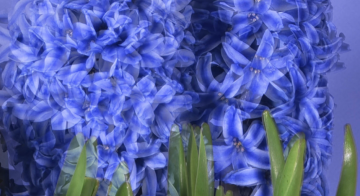
T.J. Wilcox
Spectrum
January 18, 2020 - February 22, 2020
Gladstone Gallery is pleased to present Spectrum, an exhibition of new works by T. J. Wilcox. For this show, Wilcox debuts a six-part silent film based on different colors of the rainbow. In its installation, each hue blends together and elaborates a figure or event that has been seminal to the artist’s experience in becoming an artist and as a gay man. The works in this show explore the artist’s maturation and identity in ways that are both deeply personal and universal. Alongside the film, Wilcox presents a series of new photocollages on silk based on the video works that comprise Spectrum, adding this new material to his expanding practice.
The elliptical narratives from Spectrum transform a series of visual fragments into dissected fractions of light that delve into a variety of topics significant to Wilcox’s identity and research interests. Drawing from a range of cultural sources, from documentary to mythic, the single projection film investigates Wilcox’s cathexis towards objects of popular fixation and their significance in the formation of the artist’s queer identity. With Hyacinth and Apollo and Taglioni’s Dance, Wilcox references figures engaged in the act of preservation, of cultivating their own legends. Both Apollo’s invention of the hyacinth to memorialize his lover and prima ballerina La Taglioni’s habitual reenactment of her starlit dance over the snow parallel Wilcox’s process of reconstructing a memory through the use of emblematic imagery. In the works that derive from documentary sources, Garden in Hell, Grapefruit, and Green Carnation, Wilcox similarly manipulates significant anecdotes—gathering archival footage of Vogue editrix Diana Vreeland’s red living room, meditating on green carnations as a stand-in for Oscar Wilde’s flamboyant persona and as a reference to his prosecution for gross indecency, or Yoko Ono’s book of life instructions—in order to deconstruct the process by which history is distilled from embodied living experiences. Often, Wilcox’s evocative images hold queer double-meanings, and the same holds true in Monarch Butterfly which follows the eponymous creature, commonly associated with gay men and thought of as delicate and frivolous, as it completes one of the most complex migratory events in the natural world, traveling over 8,000 miles on its paper-thin wings. Exhibited simultaneously as looped videos that are projected onto a long, narrow screen, each film has differing durations. The resulting projection creates a seemingly never-ending viewing experience within the structurally complex exhibition space Wilcox has constructed. The narratives and colors bleed into one another, creating an optically compelling story that can be read or experienced as six different films or a single image. This complexity and careful attention to creating an immersive environment is further demonstrated through the monumental scale of the single screen and the cascading rainbow that appears beneath the projection, continuing to envelop the viewer into a space that is both vibrant and contemplative.
Alongside each film, Wilcox has made a series of multi-ply silk hangings, printed with a photo-collaged images that references the source materials from each new video work. The collages borrow from documentary sources, Wilcox’s own photography, illustrations, and found imagery to construct portraits of the historical subjects or natural world. Recalling both the omnipresent flag of queer liberation and the importance of the color spectrum in the optics of film and photography, Wilcox’s hanging photographs explore both process and history with a subtle biographical edge.
T. J. Wilcox was born in 1965 in Seattle, Washington, and lives and works in New York. His work has been the subject of solo exhibitions at institutions including the Whitney Museum of American Art, New York; Grand Rapids Art Museum, Michigan; Carthage Hall, Lismore Castle Arts, Waterford, Ireland; Stedelijk Museum, Amsterdam; and Kunstverein Munich, Munich. Wilcox has been included in group exhibitions at institutions including the Museum of Modern Art, New York; Musee d’art et d’histoire, Geneva; Centro Galego De Arte Contemporánea, Santiago de Compostela, Spain; Kunstsammlung Nordrhein-Westfalen, Düsseldorf, Germany; Museum Ludwig, Cologne, Germany. His films have been screened at the Museum of Modern Art, New York, and the Tate Modern, London, and he participated in the 2015 Biennale de Lyon and the 2004 Whitney Biennial.

Salvo
January 11, 2020 - February 29, 2020
Gladstone Gallery is pleased to present an exhibition of paintings by Salvo (1947 – 2015). Focusing on the artist’s compositions of landscapes and cities, this show surveys more than 30 years of Salvo’s artistic practice and highlights his early conceptual art and his astounding aptitude for portraying the complexities of light and the passage of time. Organized in collaboration with Archivio Salvo, the works in this show solidify Salvo’s singular and ever explorative approach to artmaking and his lasting impact on Italian modernism.
Salvo, whose given name was Salvatore Mangione, was born in Leonforte, Sicily, in 1947. After permanently relocating to his adoptive city of Turin in 1968, he quickly became involved in the blossoming Arte Povera movement, which was born as a response to the social and political unrest in Italy throughout the 1960s. During this period, Salvo shared a studio with Alighiero Boetti, one of the pioneers of this radical movement. Salvo and Boetti had an ongoing relationship and reciprocally collaborative influence on each other’s practices; the combination of influences from Boetti and other artists of the time impacted Salvo’s own artmaking and understanding of the world around him. At this early stage in his career, Salvo employed conceptual strategies to meditate on the nature of artistic practice, and the role of the artist as both a preternaturally talented individual and a conduit to the past and the history of culture. An example of works from this period include a series of “self-portraits” - altered or staged photographs that depicted him as a baker, bartender, guerilla, saint, and the painter Raphael. By 1973, Salvo pivoted away from conceptual work and began to explore the radical and complex possibilities inherent to figurative painting.
The impulse Salvo felt to transform the nature of his work culminated in a powerful visual shift that preoccupied him for decades and resulted in a series of paintings with incredible depth, consistency, and nuance. Salvo’s rebuttal to the monochrome aesthetic in the hyper-saturated, imagined landscapes and cityscapes he began to depict made him an artistic outlier until the international resurgence of painting in the 1980s. The works in this exhibition, painted between 1980 and 2011, harken back to avant-garde predecessors like Giorgio de Chirico and Carlo Carrà in distilling real, imagined, and remembered spaces into a profound meditation on the passage of time. The pastoral scenes and quaint villages Salvo portrays are created with a vibrant palette of oil paints and reference architectural motifs and plant species native to the cities where he lived and worked. Unlike de Chirico and Carrà’s visual response to industrialization and modernism, Salvo’s paintings focus more specifically on complex psychological narratives and abstract concepts like time. This ability to translate the passage of time through his incisive approach to capturing differing lighting situations is further demonstrated by the titles of Salvo’s paintings; many of the works on view are named after seasons, months, or times of day. The multifaceted body of work Salvo left behind solidifies his crucial place in the history of art and lasting influence on modern and contemporary artists alike.
Concurrent to the exhibition, Gladstone will reprint Salvo: Della Pittura / On Painting / Über die Malerei (Buchhandlung Walther König), the publication from the gallery’s first exhibition with the artist in 1986.
Salvo was born Salvatore Mangione in Leonforte, Sicily, in 1947 and lived and worked primarily in Turin until his death in 2015. Solo presentations of his work include the Museum Folkwang, Essen (1977); Mannheimer Kunstverein (1977); Kunstmuseum Lucerne (1983); Museum Boijmans van Beuningen, Rotterdam (1988); Musée d’Art Contemporain, Nîmes (1988); Villa delle Rose, Bologna (1998); Galleria d’Arte Moderna e Contemporanea, Bergamo (2002); Galleria d’Arte Moderna e Contemporanea, Turin (2007); Museo d’Arte della Svizzera Italiana, Lugano, with Alighiero Boetti (2017). He also participated in Documenta 5 (1972) and the 1976 and 1988 editions of the Venice Biennale.
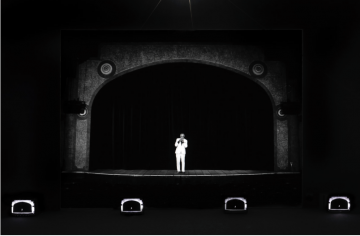
Ugo Rondinone
thanx 4 nothing (A Tribute to John Giorno)
November 23, 2019 - January 18, 2020
Gladstone Gallery is pleased to present Ugo Rondinone’s thanx 4 nothing, a mutli-channel video installation that pays tribute to the artist’s late husband, John Giorno. Rondinone reconstructs the gallery into a black box theater, creating an immersive environment through the use of black-and-white film, minimalist score, and the rhythmic intonations of Giorno’s own voice. This exhibition is a prismatic paean to the poet, raconteur, muse, cultural icon, and New York fixture.
Curator Ralph Rugoff said of the work on the occasion of its installation at Hayward Gallery in 2016:
In elegantly spectacular fashion, Ugo Rondinone’s 20-screen video installation, thanx 4 nothing (2015), presents the American poet John Giorno reciting – though ‘performing’ might be a better word – the titular poem. Written on his seventieth birthday in 2006, and framed as an extended and wide-ranging expression of gratitude to ‘everyone for everything,’ Giorno’s poetic monologue looks back over his life with frank insight and humour, reflecting on loves and losses, friends and enemies, sex and drugs, depression and spiritual acceptance. As presented by Rondinone, whose work inventively interlaces the rhythms of his images with those of the poet’s speech, it is also a dizzying meditation on duality.
Ugo Rondinone was born in 1964 in Brunnen, Switzerland and lives and works in New York. Since 2013 Rondinone has been the subject of solo exhibitions at institutions including: Kunsthalle Helsinki; Tate Liverpool; ARKEN Museum of Modern Art, Copenhagen; Bass Museum of Art, Miami; Château de Versailles; Berkeley Art Museum and Pacific Film Archive; Contemporary Arts Center, Cincinnati; Garage Museum of Contemporary Art, Moscow; Place Vendôme, Paris; MACRO and Mercati di Traiano, Rome; Carré D’Art, Nimes; Museum Boijmans van Beuningen, Rotterdam; Palais De Tokyo, Paris; Art Gallery of NSW, Sydney; Secession, Vienna; Anahuacalli Museum, Mexico City; Rockbund Art Museum, Shanghai; Museum of Cycladic Art, Athens; Kunsthistorisches Museum Wien; Museum Dhondt-Dhaenens, Deurle, Belgium; M – Museum Leuven, Belgium; Public Art Fund, Rockefeller Center; New York and Art Institute of Chicago. In 2016, Rondinone’s large-scale public work “seven magic mountains” opened outside Las Vegas, co-produced by the Art Production Fund and Nevada Museum of Art. In 2017, Rondinone curated a city-wide exhibition, “Ugo Rondinone: I ♥ John Giorno,” which honored the artist’s life partner in thirteen non-profit art institutions throughout Manhattan.

Andro Wekua
November 1, 2019 - December 21, 2019
Gladstone Gallery is pleased to present an exhibition of new work by Andro Wekua. Known for the multidisciplinary nature of his practice, Wekua has created a series of paintings and sculptures that continue his career-long exploration of the liminal space between objectivity and subjective interpretation. In works that are redolent with the artifacts of an ambiguous and undefined history, Wekua presents a series of tableaux that reveal themselves to us as emotionally familiar in spite of the artist’s gestures of obfuscation and his conscious disavowal of the formal tropes of narrative.
Using collage and assemblage as metaphors for the cognitive machinations that transform lived experience into reflection, the exhibition features a group of paintings that redeploy imagery recurrent throughout Wekua’s oeuvre. Silkscreened onto aluminum and subsequently overpainted—often gilded with silver leaf—images of palm fronds, photographic portraits, dolphins, and sections of wrought iron fence present themselves as sites of contemplation analogous to traditional icons. The artist’s continual reconfiguration of the images that define his visual lexicon indicates a compulsion to reorder the past in a search for alternative outcomes, in spite of the futility of ever finding satisfaction.
Central to the exhibition are two new bronze sculptures. The body of an androgynous child peering out from behind a palm leaf and a dolphin mimics the accretion of imagery that develop Wekua’s paintings and collages. However, its figurative relations do not liberate it from the realm of narrative inconclusion. Featureless and undefined, the figure instead remains a floating signifier suspended in anamnesis. A second sculpture of Eros encircled by a dolphin furthers the conceptual underpinnings of the exhibition. Though the object reiterates two themes found throughout the artist’s oeuvre, it was inspired by a second century sculpture located at the Farnese Collection in Naples. While Wekua presents a near duplication of the original, he alters significant details through acts of concealment and deletion. By removing Eros’s mouth and feet, Wekua directly addresses the failures inherent to the concept of the copy. Both figures’ have also been fitted with highly realistic and expressive milled glass eyes, a detail that reflects the viewer’s desire to fill in the information that Wekua withholds while simultaneously imbuing uncanny liveliness on an otherwise emphatically inanimate object.
Andro Wekua was born in 1977 in Georgia, and studied visual arts there and in Basel, Switzerland. Recent solo museum exhibitions include Kunsthalle Zürich, Switzerland; Garage Museum of Contemporary Art, Moscow; Kölnischer Kunstverein, Germany; Kunsthalle Wien, Austria; Kunsthalle Fridericianum, Kassel, Germany; Castello di Rivoli, Turin, Italy; Wiels, Brussels; Neue Kunst Halle, St. Gallen, Switzerland; Kunstmuseum Winterthur, Switzerland; Museum Boijmans van Beuningen, Rotterdam, Netherlands; Camden Arts Center, London; the De Haalen Haarlem, Netherlands; Le Magasin, Grenoble, France; and the Benaki Museum, Athens. He has participated in various group shows including “ILLUMInations” at the 54th Venice Biennale (2011); “Contemplating the Void” at the Guggenheim Museum in New York (2010); “10,000 Lives,” 8th Gwangju Biennale, South Korea (2010); “Life on Mars: 55th Carnegie International,” Carnegie Museum of Art, Pittsburgh, and the 4th Berlin Biennial (2006).

Matthew Barney
Embrasure
October 26, 2019 - December 1, 2019
Gladstone Gallery is pleased to present Embrasure, an exhibition of new drawings, etchings, and sculpture by Matthew Barney. The works in Embrasure draw from the narratives, processes, and imagery introduced in Barney’s latest project Redoubt, while expanding on its allegorical and cosmological themes.
Barney’s 2018 film Redoubt is set on a wolf hunt in Idaho’s rugged Sawtooth Mountains, continuing the artist’s long-standing preoccupation with landscape as both setting and subject. Redoubt adopts the ancient myth of Diana, goddess of the hunt, and Actaeon, a hunter who trespasses on her, as its narrative framework. In Redoubt, an Engraver, played by Barney, creates a series of plein-air drawings on copper plates as he stalks Diana and her attendants. An Electroplater in a remote laboratory subjects them to a chemical process that transforms the Engraver’s drawings: each plate is immersed in an electroplating solution, causing copper growths to form on the engraved lines. Her actions, undertaken with a ritualistic focus, transform the engravings into talismanic objects, connecting them to Barney’s work in drawing, sculpting, and performance.
The drawings in Embrasure, made with graphite and charcoal in the artist’s richly colored plastic frames, take the characters, sites, and iconography of Redoubt as points of departure into a world more ominous and strange. In these intricate drawings, Diana is rendered as a fierce deity, replete with tactical gear; Actaeon, whose mythical death is only a subtext in Redoubt, is here fully transformed and impaled on a burnt tree. Ornate fortresses of war allude to the military architecture that inspired this new project and its title; elevation maps are abstracted into feverish patterns. Barney’s fascination with the topography of Idaho is equaled here by a fixation on the celestial landscape, as the Lupus constellation – the wolf – appears in several drawings.
In Embrasure, Barney also debuts a series of etchings that combine traditional printmaking processes with the electroplating technique developed in Redoubt. In this case, a network of copper is propagated through minute pores in the paper etchings, creating nodules that partially obscure the engraved lines.
In addition to the works on paper, Barney presents a new sculpture, which he made with a tree harvested from a forest fire area in the Sawtooth Mountains. The work was made by pouring molten brass and copper into a hollowed-out recess in the tree, creating a unique cast that layers the two metals in an unrepeatable organic form.
Concurrent to the exhibition at Gladstone, New York’s Film Forum will host the theatrical release of Redoubt, which will play from October 30 through November 12, 2019. In early 2020, Landmark's Nuart Theatre will host the Los Angeles premiere of the film, followed by additional screenings around the country to be announced soon.
Matthew Barney was born in San Francisco in 1967 and lives and works in New York. Barney’s most recent project, Redoubt, premiered at the Yale University Art Gallery on March 1, 2019, and is currently on view at the UCCA Center for Contemporary Art, Beijing, China through January 12, 2020. Additional one-person exhibitions include: THE CREMASTER CYCLE, organized by the Solomon R. Guggenheim Museum, New York and traveled to Museum Ludwig, Cologne and Musée d’Art Moderne de la Ville de Paris; DRAWING RESTRAINT, organized by the 21st Century Museum for Contemporary Art, Kanazawa, Japan and traveled to Leeum Samsung Museum of Art, Seoul; San Francisco Museum of Modern Art; Serpentine Gallery, London; and Kunsthalle Vienna; and RIVER OF FUNDAMENT, organized by Haus der Kunst, Munich and traveled to The Museum of Old and New Art, Tasmania, and the Museum of Contemporary Art, Los Angeles. Barney has received numerous awards including the Aperto prize at the 1993 Venice Biennale; the Hugo Boss Award in 1996; the 2007 Kaiser Ring Award in Goslar, Germany and the San Francisco International Film Festival’s Persistence of Vision Award in 2011.
Maureen Gallace
September 21, 2019 - October 19, 2019
Walter Swennen
Leavin home but there is no home at all
September 18, 2019 - October 19, 2019
Allora & Calzadilla
Cadastre
September 13, 2019 - November 2, 2019
Dry Land
June 24, 2019 - July 26, 2019
Abstract, Representational, and so forth
June 20, 2019 - July 26, 2019
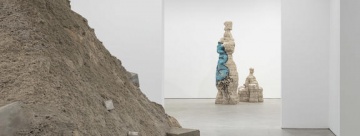
Damián Ortega
Porous Structures
May 1, 2019 - June 8, 2019
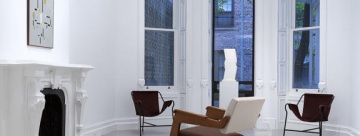
Lina Bo Bardi & Giancarlo Palanti
Studio d'Arte Palma
April 27, 2019 - June 15, 2019
Vivian Suter
April 11, 2019 - June 8, 2019
Philippe Parreno
March 6, 2019 - April 13, 2019
Ian Cheng
BOB
January 31, 2019 - March 23, 2019
Paloma Varga Weisz
Wundergestalt
January 12, 2019 - February 16, 2019
Claudia Comte
The Morphing Scallops
January 11, 2019 - February 16, 2019

Keith Haring
November 3, 2018 - December 21, 2018

Victor Man
Flowering Ego
November 1, 2018 - December 22, 2018

Ugo Rondinone
drifting clouds
September 22, 2018 - November 3, 2018
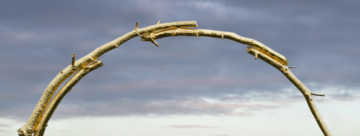
Ugo Rondinone
drifting clouds
September 22, 2018 - November 3, 2018

Banks Violette
September 15, 2018 - October 27, 2018
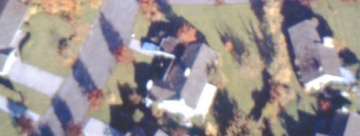
Vito Acconci, Paul Chan, Sharon Hayes, Barbara Kruger, and Rirkrit Tiravanija
Voice of America
June 29, 2018 - July 27, 2018

SAFE
June 28, 2018 - July 27, 2018

Andrew Lord
unslumbrous night
May 11, 2018 - June 16, 2018

Huang Yong Ping
April 28, 2018 - June 9, 2018

Carroll Dunham
April 20, 2018 - June 16, 2018

Robert Bechtle
March 10, 2018 - April 21, 2018
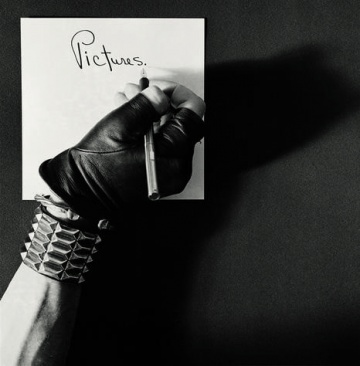
Robert Mapplethorpe
Robert Mapplethorpe: Curated by Roe Ethridge
March 3, 2018 - April 14, 2018
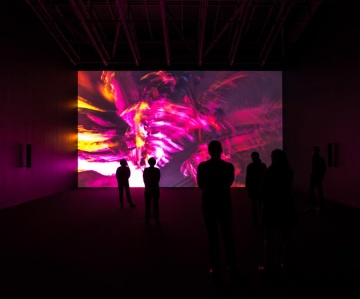
Cyprien Gaillard
Nightlife
February 23, 2018 - April 21, 2018
Amy Sillman
Mostly Drawing
January 26, 2018 - March 3, 2018
 Back to all Member Galleries
Back to all Member Galleries


